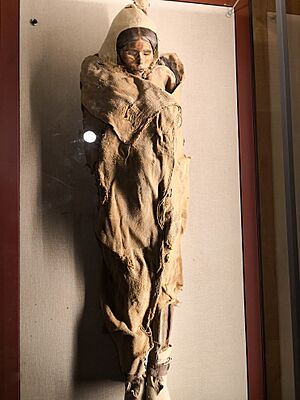Beauty of Loulan facts for kids
The Beauty of Loulan is the preserved body of a woman who lived about 4,000 years ago, during the Bronze Age. She was found on April 1, 1980, near the Silk Road in Xinjiang, China. Archaeologists Mu Sun-ing and others from the Xinjiang Academy of Social Sciences found her. She is called the Loulan Beauty because her face was so well-preserved that people still think she looks beautiful. She is one of the Tarim mummies, named after the Tarim Basin where they were discovered.
Unlike Egyptian mummies, who were preserved on purpose, the Loulan Beauty was preserved by accident. She was buried near a salt lake in a desert. The salt and dry air naturally kept her body from decaying. Even her eyelashes are still visible today!
Contents
Why is the Loulan Beauty important?
The Loulan Beauty surprised many people because she had red hair and features that looked like someone from Europe. Today, we might call her "Caucasian." This was important because the Uighurs, who live in that part of China, believe they were the first people to live in Xinjiang Province. Some of them see the Han Chinese as newcomers. Since Uighurs often look more like Europeans than other Chinese people, many thought the Loulan Beauty was their ancestor and proved their claim.
What did DNA tests show?
For many years, the Chinese government did not allow scientists to test the Loulan Beauty's DNA. They wanted to see if she was truly European or just looked that way after becoming a mummy.
In 1993, Victor H. Mair and Paolo Francalacci, an Italian geneticist, were able to test some of her tissue. They found that the Loulan Beauty was likely European, but her family might have come from Siberia. Later, in 2007 and 2009, Chinese scientists from Jilin University and Fudan University also tested her DNA. They also found she was at least partly European. Her people might have lived in Siberia before moving to Xinjiang.
However, all these tests showed that the Loulan Beauty was not a Uighur woman. This helped to calm some of the arguments about her ancestry. In 2015, the Chinese government allowed the Loulan Beauty and other mummies to travel to foreign museums as part of an exhibit about the Silk Road.
Her Life and What We Learned
Scientists learned many things about the Loulan Beauty's life by studying her body and clothes.
- She was about 40 to 48 years old when she died.
- Her height was about 152 to 155 centimeters (about 5 feet).
- Her blood type was O.
- Her hair was red.
- Her shoes and clothing were worn out and had been repaired many times.
- Her hair had lice.
- She had breathed in a lot of sand, dust, and charcoal.
- She may have died from lung failure.
- She lived around 1900 to 1800 BCE (Before Common Era).
Her Burial and Display
The mummy was wrapped in wool cloth, cowhide leather, and linen. She was wearing leather shoes. Scientists also found several clay items and some grain buried with her.
In 1980, a Japanese painter named Yamaguchi Terunari helped to restore her. Her father's side of the family was of European origin, but her mother seemed to have mixed-Asian heritage. Today, the Loulan Beauty is displayed on the second floor of the Xinjiang Museum in the "Mummy Hall." She was possibly an ancestor of the Tocharians, an ancient people who lived in the Tarim Basin.
Related pages
Images for kids
-
The Taklamakan Desert in the Tarim Basin.
-
Satellite image of the Taklamakan Desert.
-
The Taklamakan Desert is very dry, which helped preserve the mummies.
-
"Tocharian donors" with light hair and eyes, from a 7th-century CE fresco in Qizil, Tarim Basin, Xinjiang, China.
See also
 In Spanish: Belleza de Loulan para niños
In Spanish: Belleza de Loulan para niños









